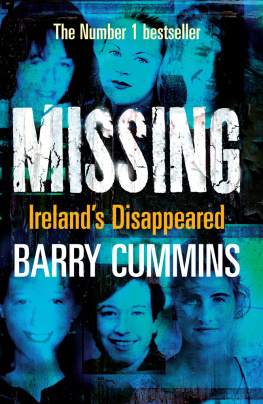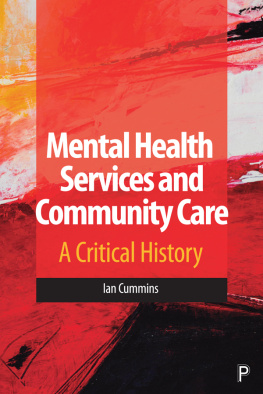
For everyone who has been lost
Introduction

B etween March 1993 and July 1998 six young women aged between seventeen and twenty-six disappeared without a trace in Ireland. It is feared that all six women were abducted and murdered. Despite intensive Garda investigations, massive media coverage and public appeals, the bodies of the six women have not been found. Their disappearance has brought untold anguish to their families and shocked a country unused to such unexplained and seemingly random violence. And, of course, there is the disturbing reality that the killers responsible have not been caught. There live among us killers who have gone to extraordinary lengths to conceal their crimes, who have not left an identifiable crime scene behind, who have somehow hidden the bodies of their defenceless victims.
Four of the families of the missing women accept the terrible fact that their loved ones have been murdered. A fifth family fear that the same fate befell their loved one but still hold out a glimmer of hope that she may be alive. The sixth family maintain that any speculation about their missing teenager being murdered is simply thatspeculation.
The trauma of the families of the six women has been laid bare in the glare of the media. Hundreds of buildings and thousands of acres of land have been painstakingly searched; suspects have been arrested and questioned; but still the mystery of the disappearance of the women remains. We will never know the emotional and physical pain they suffered in the hours or minutes after they were last seen alive. The recovery of the bodies of the missing women is crucial for the distraught families, who long for some kind of closure; it might also help prevent similar murders being committed in the future. Wherever the missing women now lie, there is evidence to link the killer or killers to each individual crime. Recovering the bodies is a must for the Garda, who know that some of the most heinous crimes to be committed in Ireland remain unexplained, undetected, and unsolved.
This book confronts the disturbing fact that a number of Irelands most evil murderers have not been caught. In each of the cases of young women believed to have been abducted and murdered in Leinster, suspects have been identified by the Garda. In three of the cases prime suspects have been identified, yet no charges have been brought. Without the bodies of the women being discovered, and without the exact crime scenes being found, the job of bringing a case before the courts is an almost impossible one. Yet each of these cases remains an active one for the detectives involved.
The first of the six women to disappear was an American woman, Annie McCarrick, who was twenty-six when she was abducted and murdered somewhere near the Wicklow Mountains in March 1993. Her disappearance devastated her parents, John and Nancy McCarrick, who are now divorced. Annie was an only child, and the fact that her body has never been found has caused great distress for her parents, who live in Long Island, New York. Growing up in an Irish-American community, Annie developed a passion for Ireland. When she was nineteen she arrived in Dublin for the first time and fell in love with Irish culture and the Irish people. She lived in Ireland for three years while she studied in Dublin and Maynooth. She developed serious relationships with two men during that time, and had a wide circle of friends. By Christmas 1992 she was back in New York and trying to decide what she wanted to do with her life. She was thinking of becoming a teacher, and she decided, once and for all, that she was going to go back to Ireland to see if she could settle down and make her life here. She arrived in Dublin in January 1993. Less than three months later she was abducted and murdered, after heading out for a walk in Enniskerry, Co. Wicklow. Her body has never been found, and her killer has never been caught.
The second woman to disappear in similar chilling circumstances was the 21-year-old Co. Kilkenny woman Jo Jo Dullard. Late at night on 9 November 1995 she was trying to hitch a lift home in Moone, Co. Kildare, when her killer stopped to offer her a lift. She had already hitched lifts from Naas to Kilcullen, and then from Kilcullen to Moone, but she was still more than forty miles from her home in Callan, Co. Kilkenny. Whoever stopped to offer her a lift at about 11:40 p.m. managed to conceal his murderous intentions. Jo Jo Dullards body has never been found, leading to one of her sisters, Mary Phelan, publicly criticising the failure of the Garda to conduct an extensive search within a twenty-mile radius of where she was last seen. Mary has also spearheaded a campaign for the establishment of a specialist Garda National Missing Persons Unit. Jo Jos disappearance has traumatised her three sisters and brother and her nieces and nephews. There are a number of suspects for this abduction and murder, but without Jo Jos body being found the killer or killers remain at large.
In August 1996 25-year-old Fiona Pender, who at the time was seven months pregnant, was lured out of her flat in Tullamore by someone she knew. At some unknown place in the midlands she was murdered, and her body was concealed. Her violent death was the second tragedy to hit the Pender family: her younger brother, Mark, was killed in a motorbike accident in June 1995; but the murder of Fiona Pender and her unborn baby was not the last tragedy to befall the Penders. In March 2000 Fionas father, Sen Pender, took his own life at the family home in Connolly Park, Tullamore.
The abduction and murder of Fiona Pender differ from those of Annie McCarrick and Jo Jo Dullard, in that the Garda believe Fiona knew her attacker. While Annie McCarrick and Jo Jo Dullard were both out walking or standing on the roadside when they were attacked by their killers, Fiona Pender was last seen at home in her flat in Church Street, Tullamore. There was no sign of a struggle or disturbance; the most credible hypothesis is that Fiona either left the flat in the company of her would-be killer or left to meet that person by arrangement. A prime suspect has been identified, but no charges have been brought.
The fourth woman to disappear was technically a child when she was abducted and murdered. Ciara Breen was a few weeks short of her eighteenth birthday when she sneaked out of her bedroom window in Dundalk in the early hours of the morning in February 1997. Whoever she was going to meet, and wherever she was going, she didnt want her mother to know about it. The Garda believe she was going to meet an older man, and that this is the person who is responsible for her abduction and murder. A prime suspect has been identified and has been questioned at length, but he denies that he even knew Ciara. Her murder has devastated her mother, who has lost her only child in the most callous of circumstances. Whoever killed Ciara Breen has taken not only Bernadette Breens only child but her best friend, her whole life.
A year after Ciara Breens murder another teenager disappeared in sinister circumstances, this time at the other end of Leinster. Fiona Sinnott was nineteen and the proud mother of eleven-month-old Emma Rose when she vanished from her home in Broadway, Co. Wexford, in February 1998. She is the only one of the six missing women who has left behind a child. A number of people have been questioned about her suspected abduction, but no charges have been brought. A major operation leading to the draining of a lake in the locality also led nowhere. A prime suspect has been identified, but, as in the other cases, without a crime scene, or a witness, or a body, a prosecution is unlikely.
Next page













